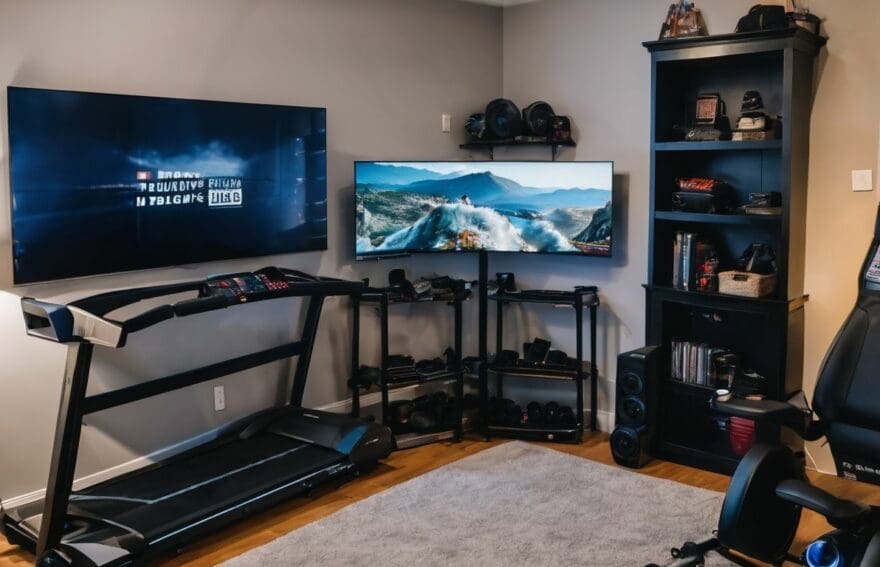Fitness in Esports: Staying Physically Active for Peak Performance

Updated On: October 24, 2025 by Aaron Connolly
As avid gamers ourselves, we truly understand the conundrum of maintaining physical fitness whilst being engrossed in the electrifying realm of esports. It’s common knowledge that leading players don’t just sit idly – they’re constantly on the move, striving for excellence.
On our blog, you’ll uncover invaluable advice on how integrating a spot of fitness into your routine can enhance your gaming prowess and sidestep potential health quandaries. So why not join us? Step up to the challenge and unleash the full spectrum of your abilities!
Physical Activity and Esports
Professional esports players understand the importance of physical activity in maintaining peak performance. Their motivation for staying physically active and their current levels of exercise will be discussed in this section.
Professional esports players and their motivation for physical activity
We know staying in top shape isn’t just for traditional athletes; it’s crucial for us as esports players too. With over 3.5 hours of gaming each day, incorporating physical activity into our routine is essential to counteract the strain of repetitive motions and prolonged sitting.
We’re motivated by the fact that regular exercise not only improves our overall health but also boosts cognitive performance, giving us an edge in high-stakes competitions.
Moreover, we’ve seen that the elite players making up the top 10% are more physically active than their peers. This clearly shows a link between fitness and peak performance in esports.
Being physically fit helps reduce fatigue during long gaming sessions and maintains sharp mental focus—vital factors when aiming to stay competitive in professional gaming circuits.
That’s why we make time for workouts, understanding they’re as important as any strategy session or practice game.
Physical activity levels among professional esports players
Understanding the physical activity levels of professional esports players is pivotal to grasping how fitness interlinks with gaming performance. Here’s a detailed look at how these athletes maintain their physical activity:
| Physical Activity FactorDetailImpact on Esports Performance | ||
|---|---|---|
| Exercise Frequency | Top 10% of players engage more in physical activity | Correlates with higher competitive success |
| Exercise Type | Combination of cardio, strength, and flexibility exercises | Improves endurance, strength, and reduces injury risk |
| Duration of Gaming | Over 3.5 hours daily | Necessitates balance with physical activity to prevent strain |
| Occupational Illnesses | Risks from repetitive strain and prolonged sitting | Physical activity mitigates these health risks |
| Health Regime | Incorporates nutrition, sleep, and stress management | Essential for maintaining cognitive function and alertness |
Players recognise that integrating exercise into their routines is crucial for staying competitive. They focus on balancing gaming with physical fitness to enhance stamina, reduce fatigue, and maintain overall health. As we continue, let’s delve into the benefits physical activity can bring to the realm of esports.
Benefits of Physical Activity for Esports
Engaging in physical activity can lead to improved performance, better overall health, and a reduction of occupational illnesses caused by a lack of exercise among esports players.
These benefits are essential for maintaining peak performance and longevity in the competitive gaming industry.
Improved performance
Regular physical activity is proven to enhance cognitive performance, positively impacting both anatomy and physiology. Studies have shown that exercise can improve brain function, which is crucial for esports players aiming to maintain peak performance.
It’s important to note that the top 10% of esports players are typically more physically active than their counterparts, underscoring the link between physical fitness and competitive gaming success.
Implementing a balanced routine of exercise alongside gameplay not only improves overall health but also enhances cognitive abilities, ultimately leading to improved performance on the virtual battlefield.
Incorporating physical activity into daily routines has been found to reduce fatigue levels and counteract the negative effects of prolonged sitting. This strategy is essential for esports athletes looking to keep up their edge during intense gaming sessions.
Better overall health
Regular physical activity can greatly enhance overall health for esports players. Engaging in exercise can lead to improved cardiovascular health, increased muscle strength and endurance, and better bone density.
Furthermore, physical activity has been shown to reduce the risk of chronic conditions such as diabetes, heart disease, and obesity. By incorporating regular exercise into their routines, gamers can also experience enhanced mental well-being through reduced stress levels and improved mood.
Esports players who prioritise physical fitness are likely to experience heightened energy levels and greater resilience against fatigue during long gaming sessions. This is important not only for maintaining peak performance but also for promoting long-term health and wellness.
Reduction of occupational illnesses caused by a lack of exercise
Once we establish better overall health, we reduce the risk of occupational illnesses caused by a lack of exercise. Sedentary behaviour in esports can contribute to long-lasting physical complaints and discomfort, impacting performance over time.
Regular physical activity not only enhances fitness but also mitigates the effects of prolonged sitting associated with gaming. According to research, incorporating exercises into our routines can significantly reduce the likelihood of these occupational illnesses and help us maintain optimal performance levels.
Embracing a physically active lifestyle amidst gaming helps counteract the negative effects often associated with extensive screen time. Engaging in regular exercise is proven to reduce fatigue levels while also enhancing cognitive function and overall wellbeing.
Effective Exercises and Methods for Esports Fitness
To stay physically active and improve performance, esports players can incorporate finger rows and peripheral chart board exercises to enhance hand-eye coordination and dexterity. Professional neuro-training can also be beneficial for enhancing cognitive function and reaction time during gameplay.
Finger rows
Professional esports players can benefit from incorporating finger rows as part of their fitness routine to counteract the physical strain caused by extended gaming sessions. These exercises, which involve flexing and extending the fingers against resistance, can help improve hand strength, dexterity, and endurance.
This is particularly important for gamers who rely heavily on fast and precise finger movements during gameplay. Research has shown that regular finger row exercises can help reduce the risk of repetitive strain injuries and enhance overall hand-eye coordination, vital for peak performance in esports.
Implementing finger rows into a daily training regimen offers significant advantages for both professional and novice esports players alike. By dedicating a small amount of time each day to these specific exercises, gamers can proactively minimise the potential negative impact of prolonged gaming on their hands and wrists while simultaneously improving their gaming skills.
Peripheral chart board
Transitioning from finger rows to peripheral chart board, another effective exercise for esports fitness is engaging with a peripheral chart board. This exercise focuses on enhancing hand-eye coordination, reflexes, and cognitive processing speed – all crucial skills in competitive gaming.
Peripheral training aids in improving visual reaction time by presenting the player with fast-paced visual stimuli that need quick and accurate responses. The use of a peripheral chart board can help esports players sharpen their ability to process information rapidly and accurately, giving them an edge in intense gaming scenarios.
Moreover, research shows that incorporating peripheral training into an esports player’s fitness routine can have positive effects on brain function and overall performance during gameplay.
Professional neuro-training
Professional neuro-training is a cutting-edge method that focuses on enhancing cognitive function and mental performance in esports players. This training involves exercises and techniques aimed at improving reaction time, decision-making skills, and overall mental acuity during gaming sessions.
Research has shown that targeted neuro-training can positively impact brain function, resulting in improved focus, concentration, and quicker reflexes. By integrating professional neuro-training into their fitness regimen, esports players can gain a competitive edge by sharpening their mental abilities for peak performance.
Esports athletes at all levels are increasingly recognising the benefits of professional neuro-training as an essential component of their training routine. Incorporating such training methods alongside physical exercise and nutrition not only contributes to enhanced cognitive function but also supports overall well-being for sustained success in the world of competitive gaming.
Nutrition and Exercise for Esports Performance
Incorporating a balanced diet and regular physical activity into daily routines is crucial for peak performance in esports. Read more about the importance of nutrition and exercise for gamers to enhance their overall gaming experience.
The importance of a balanced diet
Proper nutrition is a vital aspect of maintaining peak performance in esports. A balanced diet, rich in essential nutrients, supports overall health and well-being. Consuming a variety of foods such as fruits, vegetables, whole grains, lean proteins, and healthy fats can provide the necessary energy levels required for extended gaming sessions.
It’s crucial to avoid excessive consumption of sugary snacks and high-calorie beverages that can lead to energy crashes and decreased focus during gameplay. Ensuring proper hydration by consuming water and electrolyte-rich drinks can aid in preventing fatigue and improving cognitive function while gaming.
Incorporating nutritional choices that support physical health into daily routines is fundamental for sustaining optimal performance in esports. Focusing on a balanced diet not only fuels the body but also enhances mental acuity during intense gaming sessions.
Incorporating physical activity into daily routines
- Schedule regular breaks during gaming sessions to stretch and move around. This helps in reducing the risk of repetitive strain injuries and counters the negative effects of prolonged sitting.
- Integrate simple exercises like walking, jogging, or cycling into your daily routine to improve overall fitness levels and counteract the sedentary nature of gaming.
- Incorporate movement – based games or exergames into your gaming setup to make physical activity an integral part of your gaming sessions.
- Set specific times for physical exercise, such as morning workouts or evening walks, to ensure consistency and balance between gaming and physical activity.
- Utilise technology to track daily steps or set reminders for regular movement throughout the day, promoting a more active lifestyle alongside your gaming commitments.
- Participate in group fitness activities with fellow gamers, such as virtual fitness classes or outdoor sports, to foster a sense of community while staying physically active.
- Explore various forms of exercise that complement gaming skills, such as yoga for improved flexibility and breathing techniques for stress management during gameplay.
- Emphasise the importance of adequate sleep and hydration alongside physical activity to maintain optimal health and esports performance.
Strategies for Encouraging Physical Activity in the Esports Community
Utilising technology for movement-based games and exergames can make physical activity more engaging and fun, while promoting physical fitness within the media ecosystem can encourage a healthier lifestyle among gamers.
To learn more about how to stay physically active for peak performance in esports, keep reading!
Utilising technology for movement-based games and exergames
Esports players can incorporate technology for movement-based games and exergames to stay physically active and enhance their gaming performance. These innovative tools can help improve agility, coordination, and reflexes. Here are some effective ways to utilise technology for movement-based games and exergames:
- Virtual reality (VR) gaming allows players to engage in physical movements while immersed in a virtual environment, promoting physical activity and enhancing spatial awareness.
- Motion – sensing devices such as the Nintendo Wii or Xbox Kinect offer interactive gameplay that requires physical movements, providing a fun way to stay active while gaming.
- Gamified fitness apps and platforms combine exercise with gaming elements, offering challenges, competitions, and rewards for completing physical activities.
- Dance – based video games like “Just Dance” provide a lively way to get moving and improve cardiovascular fitness through dance routines set to popular music tracks.
- Exergaming equipment such as stationary bikes with integrated gaming consoles or treadmills that simulate outdoor environments can help esports players maintain physical activity levels while training.
Promotion of physical fitness within the media ecosystem
Transitioning from utilising technology for movement-based games and exergames, we are prompted to consider the promotion of physical fitness within the media ecosystem. Broadcasting platforms and esports content creators have a substantial influence on players and fans alike.
Integrating regular reminders about the importance of physical activity during gaming sessions, incorporating exercise challenges or workout tutorials into streaming content, and showcasing professional gamers engaging in fitness activities can help normalise physical fitness within the esports community.
Additionally, collaborations with fitness influencers or professionals to create tailored exercise routines specifically designed for gamers can contribute significantly to promoting physical well-being within the gaming environment.
Focusing on exercise for enhanced esports performance
Esports players benefit significantly from incorporating regular exercise into their training routines. Physical activity not only boosts overall health but also enhances cognitive function, improving reaction times and decision-making skills crucial for competitive gaming.
Top-performing esports athletes allocate time to incorporate exercises targeting hand-eye coordination, reflexes, and endurance to stay fit and maintain peak performance during intense gaming sessions.
Implementing a balanced fitness regimen alongside gaming enhances energy levels, reduces fatigue, and helps counteract the effects of prolonged sitting.
Conclusion
Maintaining physical fitness is paramount for peak performance in esports. Exercise, nutrition, and effective stress management play crucial roles in enhancing cognitive performance and reducing fatigue levels.
Encouraging physical activity within the esports community can pave the way for a healthier gaming culture and better overall performance. Movement-based games, balanced diets, and strategic training approaches are essential elements in promoting physical health for gamers at every level of competition.
FAQs
1. Why is fitness important for esports players?
Fitness in esports helps players stay physically active and maintain peak performance, just like athletes in other sports.
2. How does physical health affect gaming performance?
Good physical health from exercise and nutrition boosts mental alertness and stamina, making gamers more competitive.
3. What type of exercise should an esports player do?
Esports training includes regular physical exercise to counter a sedentary lifestyle and promote overall health for gamers.
4. Can focusing on fitness improve an esports player’s mental health?
Yes, staying active through fitness routines can greatly benefit the mental health of gamers by reducing stress and enhancing concentration.
5. Do all professional esports teams have fitness programs?
Many top-tier teams now incorporate tailored athlete training into their schedule to enhance the physical health and performance of their gamers.


